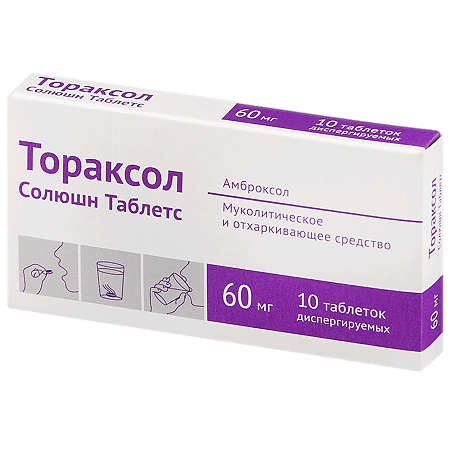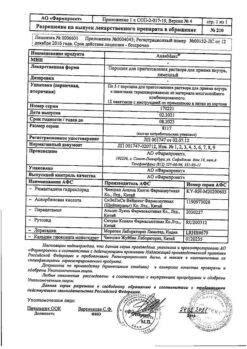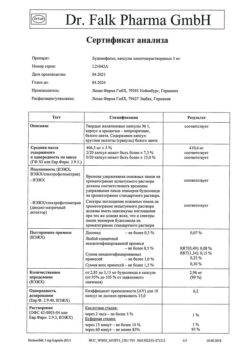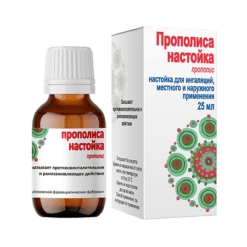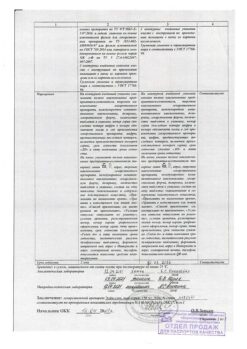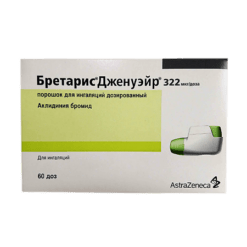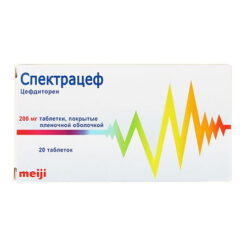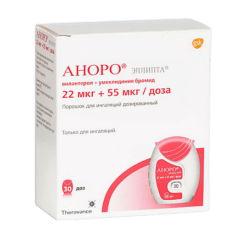No products in the cart.
Toraxol Solution Tablets, 60 mg 10 pcs
€1.00
Out of stock
(E-mail when Stock is available)
Description
Ambroxol has secretomotor, secretolytic and expectorant action: it stimulates serous glands cells of bronchial mucosa, increases the content of mucous secretion and release of surfactant (surfactant) in alveoli and bronchi; normalizes the disturbed ratio of serous and mucous components of sputum. By activating hydrolyzing enzymes and increasing the release of lysosomes from the clara cells, it reduces the viscosity of sputum. Increases the motor activity of the cilia of the atomizing epithelium. Increases the flow and transport of mucus (mucociliary clearance). Increased mucociliary clearance improves sputum discharge and facilitates cough.
Pharmacokinetics
Ambroxol is characterized by rapid and almost complete absorption from the gastrointestinal tract (GIT) with a linear dependence on the dose in therapeutic concentration range.
Bioavailability is 70-80%. Maximal concentration (Cmax) in blood plasma is reached after 0.5-3 hours when administered orally. In the therapeutic range of concentrations binding to plasma proteins is approximately 90%.
Transition of ambroxol from blood to tissues during oral administration occurs rapidly.
The highest concentrations of the active component of the drug are observed in the lungs. It penetrates through the blood-brain barrier, placental barrier, excreted with breast milk.
About 30% of the administered oral dose is subjected to the effect of primary passage through the liver. Studies on human liver microsomes have shown that CYPCA4 is the predominant isoform responsible for ambroxol metabolism. The remainder of ambroxol is metabolized in the liver to inactive metabolites. The half-life (T1/2) of ambroxol is 10 hours. Renal excretion: 90% as metabolites, 10% unchanged.
No clinically significant effect of age and sex on ambroxol pharmacokinetics was found, so there is no reason to adjust the dose by these characteristics.
Indications
Indications
Acute and chronic diseases of the respiratory tract with the release of viscous sputum: acute and chronic bronchitis, pneumonia, chronic obstructive pulmonary disease, bronchial asthma with difficulty in sputum discharge, bronchiectasis.
Pharmacological effect
Pharmacological effect
Ambroxol has a secretomotor, secretolytic and expectorant effect: it stimulates the serous cells of the glands of the bronchial mucosa, increases the content of mucous secretion and the release of surfactant in the alveoli and bronchi; normalizes the disturbed ratio of serous and mucous components of sputum. By activating hydrolyzing enzymes and enhancing the release of lysosomes from Clara cells, it reduces the viscosity of sputum. Increases the motor activity of the cilia of the ciliated epithelium. Strengthens the flow and transport of mucus (mucociliary clearance). Increasing mucociliary clearance improves sputum discharge and relieves cough.
Pharmacokinetics
Ambroxol is characterized by rapid and almost complete absorption from the gastrointestinal tract (GIT) with a linear dose dependence in the therapeutic concentration range.
Bioavailability is 70-80%. The maximum concentration (Cmax) in blood plasma after oral administration is achieved after 0.5-3 hours. In the therapeutic concentration range, binding to plasma proteins is approximately 90%.
The transition of ambroxol from the blood to tissues when administered orally occurs quickly.
The highest concentrations of the active component of the drug are observed in the lungs. Penetrates the blood-brain barrier, placental barrier, and is excreted in breast milk.
Approximately 30% of the administered oral dose undergoes first pass through the liver. Studies on human liver microsomes have shown that CYP3A4 is the predominant isoform responsible for the metabolism of ambroxol. The remainder of ambroxol is metabolized in the liver to inactive metabolites. The half-life (T1/2) of ambroxol is 10 hours. Excreted by the kidneys: 90% in the form of metabolites, 10% unchanged.
No clinically significant effect of age and gender on the pharmacokinetics of ambroxol was found, so there is no basis for dose adjustment based on these characteristics.
Special instructions
Special instructions
Ambroxol should not be taken simultaneously with antitussive drugs, which may inhibit the cough reflex.
Ambroxol should be used with caution in patients with a weakened cough reflex or impaired mucociliary transport due to the possibility of sputum accumulation.
In seriously ill patients, aspiration of liquefied sputum should be performed.
In patients with bronchial asthma, ambroxol may increase cough.
Ambroxol should not be taken immediately before bed.
In patients with severe skin lesions – Stevens-Johnson syndrome or Lyell’s syndrome – fever, body pain, rhinitis, cough and sore throat may appear in the early phase. During symptomatic treatment, it is possible to erroneously prescribe mucolytic agents such as ambroxol hydrochloride. There are isolated reports of the identification of Stevens-Johnson syndrome and Lyell’s syndrome, which coincided with the prescription of the drug; however, there is no cause-and-effect relationship with taking the drug.
If the above syndromes develop, it is recommended to stop treatment and immediately seek medical help.
If kidney function is impaired, ambroxol should be used only on the recommendation of a doctor.
Active ingredient
Active ingredient
Ambroxol
Composition
Composition
For 1 tablet:
Contraindications
Contraindications
Hypersensitivity to ambroxol or one of the excipients; phenylketonuria; pregnancy (first trimester); lactation period.
Children up to 12 years of age (for dispersible tablets 60 mg).
With caution
Impaired bronchial motor function and increased sputum production (with fixed cilia syndrome), peptic ulcer of the stomach and duodenum during an exacerbation, pregnancy (II-III trimester).
Patients with impaired renal function or severe liver disease should take ambroxol with extreme caution, observing long intervals between doses of the drug or taking the drug in a lower dose.
Use during pregnancy and breastfeeding
Ambroxol penetrates the placental barrier. The drug is not recommended for use during the first trimester of pregnancy. If it is necessary to use ambroxol in the II-III trimesters of pregnancy, the potential benefit for the mother should be assessed with the possible risk to the fetus.
During breastfeeding, the use of the drug is contraindicated, since it is excreted in breast milk.
Side Effects
Side Effects
Gastrointestinal disorders: heartburn, dyspepsia, diarrhea, nausea, vomiting, pain in the upper abdomen, decreased sensitivity in the mouth or pharynx, dry mouth and throat, dysgeusia (impaired taste).
Allergic reactions: allergic reactions (including anaphylactic shock), angioedema, skin rash (exanthema), urticaria, itching and other allergic reactions. Stevens-Johnson syndrome, Lyell’s syndrome.
Interaction
Interaction
When used with antitussive drugs, it may be difficult to discharge sputum as a result of suppression of the cough reflex. When used simultaneously with amoxicillin, cefuroxime, and erythromycin, ambroxol increases their concentration in bronchial secretions. No clinically significant adverse interactions with other drugs have been reported.
Overdose
Overdose
Symptoms: heartburn, dyspepsia, diarrhea, nausea, vomiting, pain in the upper abdomen. In case of severe overdose, a decrease in blood pressure is possible.
Treatment: artificial vomiting, gastric lavage in the first 1-2 hours after taking the drug; intake of fat-containing foods, symptomatic therapy.
Storage conditions
Storage conditions
At a temperature not exceeding 25 °C. X
injure in places inaccessible to children.
Store the blister pack in a cardboard package (pack).
Shelf life
Shelf life
3 years. Do not use after expiration date.
Manufacturer
Manufacturer
Ozon, Russia
Additional information
| Shelf life | 3 years. Do not use after the expiration date. |
|---|---|
| Conditions of storage | At the temperature not more than 25 °С. X keep out of reach of children. Keep the contour cell pack in a cardboard box (package). |
| Manufacturer | Ozon, Russia |
| Medication form | dispersible tablets |
| Brand | Ozon |
Related products
Buy Toraxol Solution Tablets, 60 mg 10 pcs with delivery to USA, UK, Europe and over 120 other countries.

